“Goooooooood morning divers!! Great day for a day man!” Mikey Kent, Park Diving Officer for Dry Tortugas National Park (DRTO) greets us. Perhaps no one in the National Park Service experience has a more pervasive reputation than Mikey Kent. He has medium length salty blonde hair, is covered in nautical tattoos, and probably has never had a bad day in his life. He is always doing something- playing, working, or both. And as someone once told me, “Mikey has never met anyone he didn’t already know for 30 years.”

“I’ve been told I need to work on my professionalism.” No Mikey, never change. Photo credit: Mike Feeley
I am prepping dive gear, snacks, and underwater clipboards for the dive team I’m with for the day. Mikey meanders his was through the Fort Jeff greeting each person he sees (Fort Jefferson is the full name of the boat, but it is known as Fort Jeff to distinguish the boat from the actual fort with the same name). “J Mills, you are looking extra sharp today my man!” J Mills is Mikey’s nickname for Jeff Miller. Jeff is a coral biology and disease specialist on the South Florida Caribbean Network (SFCN) monitoring team that I am with at DRTO. He is quick witted, sports board shorts covered in sumo wrestlers, and states, “it goes without saying, so I’ll say it again, my unpredictability is my predictability.”
I’ve been diving with Jeff for two days finding metal rods that mark coral survey sites underwater. The goal is to find all of the pins, layout a transect tape (underwater measuring tape) connecting the pins, and survey coral species and disease that are within a meter of the tape on each side. Once SFCN has the data, they inform the park’s decisions on how to properly manage their natural resources (in this case, marine environment/life). The trick is that the pins can be difficult to find. The tops of the pins- about the size and shape of a half dollar- protrude from the coral reef by as little as 3 centimeters and are often overgrown with coral and algae. Looking for these pins with “J Mills” (who has over 7,000 dives to his name) may be the most humbling experience I’ve ever had underwater. Jeff finds pins without a compass that take me and the other divers 20 minutes to find.
“You coming sailing tonight?!” Mikey asks me. “Wouldn’t miss it, I”ll be there!” I respond as I am passing the day’s lunch cooler, cylinders (SCUBA tanks), and cameras down to my team’s boat, which is side-tied to the Fort Jeff. One final gear check and we cast off to conduct coral surveys at “Santa’s Village”- a reef site in the far north of the park.
It all started 2 days ago when Mike Feeley, Andy Davis, Kelly O’Connell, and Jeff picked me up from a rented Submerged Resources Center (SRC) house near Biscayne National Park. I was told about the SFCN team from many people before I actually met them. I think the best summary came from Bert Ho of the SRC, “they’re a great team of guys who know their stuff, you’ll love ‘em.”
Mike Feeley is the team lead at SFCN and greets me in the truck. Mike is a tall, barrel-chested man with a deep voice. He has a Michigan heart but a Miami aesthetic. He’s also perhaps the most even-keeled person I’ve ever met and keeps his team steady. We meet Lee Richter and Rob Waara in Key Largo and I get in their truck.
“Are those guys going to lunch at Subway?! Wow! I can’t believe they are doing that, Subway is god-awful. We are going to Chad’s Deli, their portabello sandwich is out of this world! You definitely lucked out in the lunch department,” Rob tells me. “We need to stop at Office Depot first to get some Cheese Balls.” Lee interjects, “most important item in the truck! Though it is a little concerning you can’t get them at a grocery store.” Lee and Rob are a funny duo that work very well together. Rob is the Dive Officer for SFCN. He commutes about an hour and a half to work so that he can live on an island, speaks very quickly, and has a soft spot for Recess Peanut Butter Cups. Lee is in his late 20’s. Him and Rob love to kiteboard. Lee is kind of guy you’d like your daughter to date. He is always smiling, loves The Life Aquatic, and is exceedingly patient as I come to find out.
“If we are doing portabellos, we need to call them in, they take 20 minutes to cook,” Rob warns us. Lee tries to call the deli, but can’t get through. While Rob parks the truck with the trailer, Lee and I put in the food order. “If it looks like it’s going to take a while, forget the portabello,” Rob tells us. Lee decides Rob is probably exaggerating and orders the portabello sandwich for Rob. We wait…and wait…and wait. All the while, Rob is both very bored in the car and increasingly worried that we are running later and later with each passing moment. So he calls Lee after about 5 minutes. “Hey Rob, yeah we put in the order. It’s coming, we’ll be out there soon buddy.” He calls again. He texts. He calls again. “I love Rob, he’s a brother to me. But it’s exactly that- he’s a brother to me,” Lee laughs without expressing even the faintest frustration.
“I wasn’t exaggerating! I don’t know how they cook those portabellos, they take forever but man are they delicious!” Rob says back on the road. We get down to Key West where the Fort Jeff is docked on a Coast Guard/Navy base. After unloading food, gear, and smaller boats onto a bigger boat, we go to dinner in Key West.
Key West is a funny place. It reminds me a bit of the port town of Tortuga from Pirates of the Caribbean. It is a small salty community where most residents’ skin looks like leather from decades of saltwater and sun and you can’t go down a grocery aisle without hearing about so-and-so’s kid who is off sailing to Grenada. We’re going to dinner that night in a “kind of sketchy” place near Key West, according to Mike.
The restaurant is on Stock Island, a “kind of sketchy” place according to Mike Feeley. It’s right on the water and hosts a strange mix of salty leather-skins and tourists inside. Before we enter, we see the most intricate and impressive truck I’ve ever seen (albeit in the trashiest way). It is covered in plastic sea creatures and seascapes have been painted all over the exterior.
In the restaurant, we meet Benjamin “Ben Jammin’” D’Avanzo. Benjamin is a “buoy boy,” he installs and maintains buoys for NOAA’s Florida Keys National Marine Sanctuary. He sports a blonde Mohawk, dives in tights with rainbow unicorns on them, and enjoys fine vegan cheeses. I share some jokes and get to know the SFCN team over dinner. We call it a night fairly early to get ready for the next day’s voyage, though it’s not exactly an early start.
9:00 AM casually rolls around and we cast off for DRTO. I’ve never seen so many islands in my life. Coming out of Key West, there are endless sandy islands skirted with green mangroves.
After a 5 hour tour, we arrive to the real Fort Jefferson at Dry Tortugas National Park. The fort is a massive work of masonry. Constructed in around the time of the Civil War, it is a large brick hexagon surrounded by a moat that used to have a crocodile in it. We tie up and I head out for a check out dive with Rob and Kelly O’Connell. Kelly is SFCN’s intern and a master’s student at the University of Miami. She loves coral biology, packs lunches for everyone on the boat, and gets sunburnt easily.
“Well, it’s day 3 of the hostage crisis,” Mike says as the Caribbean sunrise shines through the tinted windows of the Fort Jeff. I’ve been working with Elissa Connolly-Randazzo quite a bit so far. I also worked with Elissa at Biscayne National Park. Elissa is a spunky Jersey girl who has a personality that enabled her to thrive as the only female volunteer with the SFCN crew for years. She previously lived at DRTO as an intern and has a more intimate knowledge of the park than Ben, Kelly, or myself.
Underwater, I am starting finding my groove searching for survey pins. Elissa and I are mostly meeting our goal of setting up all transect tapes at each site we go to for Rob, Jeff, and Ben to survey. After setting our personal record of finding all pins and setting up a site in 35 minutes (including a safety stop!), we get back to the Fort Jeff at Fort Jefferson (getting it yet? Neither am I, don’t worry).
“The groupers are under the boat! I see 3 of them! No, 4! I mean 5!” Elissa says excitedly. I stop putting away gear and go look. 5 goliath groupers are under the Fort Jeff. I’ve only seen 1 or 2 at a time under the dock and the boat. Growing up to 8’ long and weighing up to 600 pounds, they are the biggest finfish in the region. I’ve been wanting to jump in the water with them and take some photos since I arrived.

The goliath groupers were a welcome sight for me. Here’s one going in for a light snack under the Fort Jeff.
“Mike, can I jump in and take some shots of the groupers?” I ask, with nothing to lose. “If the ship’s crew is ok with it, sure!” Mike responds. I run to find the crew, get cleared to free dive, and grab my camera.
Elissa and I plan our entrance strategy, and enter the water under the pier. We talk at the surface near the groupers. “I not going to lie, I’m a little nervous. These fish are way bigger than me,” Elissa tells me. “We’ll see how they react, but try to get face to face with one if you can and I’ll do what I can to get the shot,” I tell her. I take a big breath in and dive down. Elissa gets pretty close to a grouper, but I have to get even closer since I have a wide-angle lens on my camera. I exhale quickly at the surface and look at the shots that I just took. They are awful. I set my exposure for the sunny spot between the pier and the boat. Elissa and the fish are in the shadow of the boat. The photos are completely black. “Did you get it?!” Elissa asks anxiously. “…We are going to have to do that one again,” I tell her.

Elissa was really patient with me as I tried to get the right shot. Even though we weren’t limited on how long we could be in the water, we were limited on how long we could stay under since we were free diving.
What follows is a religious experience. The sunlight gleams through the pier onto Elissa and the groupers as we become completely calm with the giants below the surface. Everything is quiet except for the swooshing of the groupers’ cadual fins (tails), the shutter of my camera, and the boat rocking in the wind chop at the surface.
These photos are important to me. The goliath grouper has been protected for quite some time in Florida, but there is pressure now from the fishing industry to remove protection. Though populations have recovered wonderfully in certain areas, the population as a whole has not. Goliath’s are slow growing fish that are extremely susceptible to overfishing. Photos that humanize the fish and bring a living, breathing, beautiful animal to people that may not otherwise see them can sometimes turn the tide in a debate like this. While I don’t have any expectation that my photos will be the catalyst, I hope that they can play a part.

Sometimes your best shots are unplanned. After swimming underneath the Fort Jeff, I came upon this giant, pointed the camera up, and just reacted.
After shooting the goliath’s for a while, we go towards the stearn of the ship. There is a big school of silversides (small baitfish) under the pier. I imagine a shot in my head and dive down. I use my strobes (flash) for the shot. They create an extreme reflection off of the fish and it looks like thousands of small strobes flashing back into my camera. The photos are horrible. I dive down again and turn off the strobes. That looks bad too and I can’t get close enough to the school with the wide angle lens to capture them. I try again, strobes on but placed differently. No dice. After about my 20th dive, I get pretty frustrated. I can’t create the shot I am imagining. I decide to try something new. I turn the strobes to flash at my own ears, behind the camera, to diffuse the light more. I dive down to the seafloor and shoot the school from the bottom up. The school moves closer to me when I’m at the bottom. My strobes fire and I swim to the surface. Finally, I get the shots I was thinking of.

This baitball of silversides was frustrating and, eventually, rewarding to shoot. I was really happy with this shot.
“Hey, how’d the photos turn out?!” Curtis Hall, Park Ranger at DRTO, asks me. “You have some time right now? I can show you!” I say. He invites me up to his place. It is a beautiful apartment inside of the fort that is marked by a giant arch over the living room/kitchen. As we go through the photos, Curtis seems pretty happy with my work. “It’s a learning process for me. It’s all still really new and it’s a lot of guess work, but I’m pretty happy with some of these,” I tell him. As we get talking about my internship, he asks me what I’d like to do after I graduate. I tell him I’d like to work in media and/or scientific diving. I express my concern to him about the former, “I don’t know that I could make any money in media.” He replies, “With these photos, I think you could!” Hearing that sort of encouragement from an NPS employee was pretty special and gave me a little bit of validation to the thought that I am progressing behind the camera. I may be far from becoming an expert, but at least I’m better than I was last week, and that is exciting for me.
“Day 5 of the hostage crisis.” Today is different. We are diving a site called “LH-4,” meaning it is near Loggerhead Key- a small sand island near the Fort Jefferson that is home to a large lighthouse, many nesting turtles, and not much else. LH-4 is special because there is a photogrammetry site there. Jeff asks me to bring my camera on the boat today. “You know, you don’t have to twist my arm about it Jeff,” I respond jokingly.
Jeff and Rob brief me on the photogrammetry project. There is a rectangular plot we will set up underwater. Then, in a lawnmower-like fashion, we will swim up and down the plot, taking as many overlapping photos as possible from both birds-eye and side profile views. Once we have the images, they will go into a software program that will stitch them together and build a 3D model of the reef. Rebuilding the model each time they visit the site and comparing it with previous models will enable SFCN determine the health and growth of the reef over time.
I start the lawnmower up and about 600 photos later, I’ve completely covered the reef. Since I completed my task, I start taking photos of corals and everyone else working. Once we get topside, Jeff states, “that was a tough dive for me, I was really having a hard time with my buoyancy down there.” He then jokingly gleams at me, “you need to delete those photos of me, I looked like crap down there!”
We return to the Fort Jeff, put away our gear, and none other than Mikey Kent strolls through the main cabin, “ anyone trying to float tonight?” It took me a second to realize what he was saying. “Are you sailing tonight?” I ask. “It’s Dry Tortugas National Park man! Of course we are going sailing!” Mikey responds.
Mikey, Ben, and I head out to Mikey’s small catamaran that he brought over on the Fort Jeff from Key West. “You learn the basics of sailing and then it’s kind of like, you see whatever makes the boat move and go with that,” Mikey tells me. We push off and head away from the island. The wind is calm and it is nearing sunset. The boat is so light that even the slightest bit of wind gets the boat moving pretty quickly. We cruise over the shallow waters upshore of the Fort Jefferson and see nurse sharks chasing each other (it is mating season!). “Time to get into sunset position boys,” Mikey states as he maneuvers the rudder with his foot. We sail around the fort while Mikey tells us about the time he sailed to Cuba from Key West in this boat. “I was trying to grow out a mustache for Cuba for 5 weeks. My mom called me home and I had to shave it. Momma’s house, momma’s rules…5 weeks though! It killed me!” Mikey’s story soundtracks a beautiful sunset. Pinks and oranges light up the water and sky just beyond the brick walls of the fort. “I messed up! I should have brought my camera, it’s calm enough that it would have been safe on deck in a dry bag,” I tell Mikey and Ben. “You didn’t mess up man, you’re on a sailboat!” Mikey states. I agree and remember a quote from one of my favorite photographers, “some of my best photos are the ones I never took with a camera.”
“Day 6 of the hostage crisis,” Mike states in his morning brief. Today I’m switching boats with Kelly. My new dive buddy is Andy Davis, a Brazilian with the faintest accent I’ve ever heard an English-speaking Brazilian have. Mike and Lee are also on my new boat, the “mini v,” which is the smaller of the two SFCN boats.“We have strong knees and shoulders on the mini v,” Mike warns. It’s a 19-foot catamaran and much less spacious and stable than the boat I was on for the first five days. “Have fun trying to get ready on that little boat with all those big guys!” Kelly teases me.
After spending quite a bit of time topside on the mini v, I find that it is a little slower and a lot wetter than the big boat. While I am on the surface, so is Andy. It’s the first time I’ve spoken with him at length. He has lived in the US Virgin Islands or Florida for the past 10 years or so, but still has a strong connection back home in Brazil. His sense of humor is subtle, and he should pride himself on his carefully crafted one-liners.
It takes one dive for Andy and I to get dialed in to how each work underwater. Things run smoothly and we are finding pins really quickly. We also begin downloading information underwater from “hobos”- a device that stays submerged at a survey site permanently and measures water temperature over many years.
After I cook a stir-fry dinner for the SFCN team, I go with Kelly to a potluck hosted by the DRTO staff and interns. It’s at a picnic table situated in front of a large opening in the fort’s second story looking over the sunset. I meet 4 humans, 2 birds, and 1 dog. The humans are Megan, Tracey, and Yung, three of the interns at DRTO, and Kayla, a DRTO biologist. “This bird is awesome, and this one will bite your face off,” Kayla warns me as she dawns a parrot on her shoulder and one on her fingers. As Kayla intermittently flips the bird on her fingers upside down, I ask Tracey where he’s from. He tells me rural Pennsylvania, “we had days off of school for the beginning of deer season.” We laugh and try to guess what Mikey is saying as we see his boat flying on the water in front of a gorgeous sunset. I look towards the fort’s lighthouse and see incredible colors on the horizon. “Thank you guys for having me and I’d love to stay longer, but I need to go shoot the lighthouse!” I run out of the potluck through the archways of the fort, grab my camera, run up the spiral staircase, and then down the sandy path the lines the roof of the fort. The colors are fading fast. I mostly missed it. I’m kicking myself for not getting there earlier.
I’ve been weathering strong winds for four straight nights on top of the fort trying to get the perfect shot of the lighthouse. There are incredible lightning storms that form every night on the horizon behind the lighthouse. They are so far in the distance and happen at such irregular intervals that I haven’t been able to capture that moment yet. The lighthouse is my Moby Dick at the fort so far. It’s the most obvious thing to shoot, and perhaps the easiest, which makes it the hardest thing to make interesting.
- I may not have gotten the shot of the lighthouse I wanted, but I still came away with some fun shots.
- The lighthouse at blue hour.
“Day 7 of the hostage crisis.” The crew is noticeably more tired at this point in the trip. Spirits are still high, but the mood is slightly heavier. I step outside the Fort Jeff to start getting my gear ready. It’s pouring rain. Mike and Rob are outside as well getting their rebreather gear together while having a spirited debate about diving operations. I decide to go back into the ship as Lee is looking outside. “They’re like two parents sometimes, they’ll be laughing about this in 10 minutes,” he says.
Sure enough, 10 minutes later, Rob and Mike come in with smiles on their face. “We’re going to try to do a shorter day today,” Mike tells the SFCN crew. “…And, it’s grill night! I’m grilling fish, steaks, chicken, portabello mushrooms, vegetables, corn, you name it, I’m grilling it!” Rob announces. Though this is welcome news to the crew, though the reaction is a little muffled by the lethargy in the room.

I didn’t write about it, but this jelly was incredibly hard to photograph for me. I was so excited to see one and took about 30 photos before it ascended further than I wanted to go. This was the only useable shot.
The mini v takes off for a shorter, but challenging diving day. We dive a site that hasn’t been visited in many years. Some of the survey pins are missing and it takes a lot longer to do out work. But as Andy and I reach our safety stop, we see a silky shark.
Two hours later, Mike and Lee ascend from their dive absolutely elated. “That was incredible,” Mike starts telling us. “I heard you screaming at me through your rebreather and I couldn’t figure out what you wanted! And then I saw it, a manta doing summersaults only a meter away from us!” Lee continues. “Did you get the shot?! I saw you with the iPad” Mike asks. “I tried, but it asked me for the password to sign in and I didn’t want to mess with it, so I just enjoyed the experience,” Lee says. We all let out a collective sigh, but are really excited. As Mike sums it up, “it’s one of those ocean moments you’ll never forget.” However, as it always is with the SFCN team, Lee doesn’t get off the hook so easily. Once the rest of the team hears the story, it becomes a running joke. “I saw a [insert animal name here]! Shaun, you should totally put that in your blog! Oh…except Lee didn’t get a picture of it…”
We return to the Fort Jeff and are greeted by Chef Rob. He’s laid out quite the feast to grill. While he’s grilling, Mike and Mikey take off for a sail. As team lead, Mike takes the brunt of the work for SFCN, so the crew is really supportive of him going out and having some fun. Everyone digs into the mahi mahi and mashed potatoes to the sound of 1970’s era pop music- Steely Dan, America, and Carroll King. Smiles and laughter fill the room when Jeff loudly states, “can’t have potatoes without BBQ sauce!” All the while, Lee is doing his best Rob impression by saying Rob’s favorite exclamation, “whoa!”
As the sun goes down, we all talk about how happy Mike is going to be when he gets back from sailing. Not only is he sailing rather than working, but he’s with Mikey. You’d have to be in a pretty sour mood to not have fun with Mikey.
About 10 minutes later, a soaking wet Mike Feeley comes into the Fort Jeff, grinning from ear to ear. “We were flying out there, a lot of good runs!” Mike recalls. “Man, we almost lost me! I was holding onto the rudder while my body was skipping like a pebble and DMF (Mikey’s name for Mike) uses some big man strength and pulls me on board! It was awesome!” Mikey says as we all crack up at the story. Mike and Mikey dig in to the food as well and we all enjoy a wonderful night together.

The grounds of Fort Jefferson used to bustling with 400 some soldiers and held many more buildings that have since fallen or burned down.
Some incredible diving and Mike’s sailing adventure breathe new life into the crew. After two more days of coral surveys, we have finished everything that SFCN set out to do. On this morning, Mike tells us “the goal is to be back by about 2:30, so we can pack up and help load the back deck.” We are going to Tortugas Bank, a reef just past the park boundary that starts in 90 feet of water and goes down to 130 feet. Mikey Kent yells out as we start loading the boat, “what are we doing today boys? Banging tanks and blowing bubbles?!”
Jeff, Ben, Mike, and Andy drop in first. Rob is at the helm while we live boat from the surface. “Dolphins!” someone shouts. “I really wish someone had a nice camera so we could capture this magical moment at sea,” Rob says as he looks at me sarcastically. As I am scrambling to get my snorkel gear on and camera ready, the pod leaves as quickly as they came. A similar moment happened earlier in the trip when Elissa and I saw a sailfish that came right up to the boat. It hung around for no more than 2 seconds. Earlier in the trip I would have been pretty hard on myself for not getting the shot, but I’ve come to realize that I can’t get every photo and am (mostly) at peace with that.

The reefs around Dry Tortugas can be covered in macroalgae or be partially diseased. This was a nice patch to find!
The divers surface and Jeff says “the structure is beautiful, but that was a pristine reef 20 years ago and very little of it is left.” Since the reef wasn’t as Jeff remembered it and the visibility wasn’t as good as we were hoping for, we decide to do our second dive at a survey site that Andy and I dove on. The structure around the site looked really cool but we didn’t have time to explore it before. Once we arrive, I buddy up with Lee.
We descend onto swim-through arches and caves all around us. Visibility isn’t excellent, but the topography and fish are amazing. I find myself scrambling on dives like this to get the photos I want while keeping up with the other divers. I feel like I am winging it with the photos in order to not hold up the group, but I really don’t have the time I need to set up the shots. That being said, I don’t let it stop me from enjoying the dive.
Our next stop is Loggerhead Key. It’s a bigger island than Garden Key, where the fort is, and is home to a big historic lighthouse. “Wow, we haven’t had visibility like this all week!” Mike says as we get to dock. I dry the big glass dome that holds my camera lens to try my hand at the ever-famous “over-under” shot, where half the photo is underwater and half is above water. I walk in the ocean from the beach carefully, remembering the warning Chris Milbern (2016 OWUSS Rolex Scholar) gave me, “if your dome is wet, your over-unders will be covered in water droplets.”
After a few over-unders, I go below the pier to take some photos of the schools of fish there and then hop out. Mike told us we had enough time to walk the island end to end, so I decide to do exactly that. I start at the lighthouse, take some photos, and then walk up the beach. “Loggerhead Key is the best thing this park has to offer on land.” Mikey has been saying this since we got to DRTO. As amazing as the fort is, Loggerhead is truly special. It’s exactly what you imagine when you imagine paradise- a small sand island with a few coconut trees and skirted by bright blue, crystal clear water.
- The crystal clear, blue waters of Loggerhead Key.
- A barracuda cruises the clear waters of Loggerhead Key.
- The lighthouse at Loggerhead Key.
- A school of fish around Loggerhead Key.
- The far end of Loggerhead Key. In the Dry Tortugas, one storm can turn this into two islands pretty easily.
- Lee is always having fun- above or below the surface.
- I was pretty happy to see these schools of fish underneath the pier when we arrived at Loggerhead Key.
As I walk around the island, I notice two other things. The first is the amount of turtle nests. The DRTO natural resource team marks current nests on the island and there are hundreds. The second is the amount of trash washed up on the beach. Loggerhead key isn’t close to anything. It may not be as remote as some islands in the pacific or near the poles, but you certainly aren’t going to get on your kayak and paddle over there on a Sunday afternoon. Most of the trash is plastic, which looks exactly like the jellyfish that many turtles eat. The juxtaposition of the plastic near the turtle nests was heart breaking. I put as much trash in my bag as I could going back to the boat.

Trash washes ashore at Loggerhead Key. Pesticide like Raid and plastic are incredibly harmful to turtles and other marine life that surrounds the island.
Back on the boat, Lee, Ben, and I revel in the 1990’s music channel on our boat’s satellite radio. We sing along to 90’s classics while the rest of the team comes back to the boat. “I wish you would step back from that ledge my friend!” we sing along to Third Eye Blind’s hit as we go back to the fort.
Soon after, dinnertime rolls around on the boat. “Whoa! Mustache! You know what? I am going to join you, I like this idea,” Lee states after seeing my newly-shaved mustache. “Last night on the boat is a special occasion that calls for some facial hair festivities,” I tell him. We all begin recalling funny jokes from the trip and bring up memories. Before I go to bed, Mikey tells me, “you have to leave that mustache for when you go to St. Croix!”
It’s 9 PM in Miami’s Wynnwood art’s district. The walls are covered in street art, traffic moves slowly while cars stop to talk to friends on the street, and loud music plays from every corner. “You know, they were never worried about you once,” Kelly tells me. “Plus, they gave you a nickname. I think they liked you,” she continues. Mike started saying my name in a peculiar (and hilarious) way early in the week. It was like he was lifting really heavy weight that he needed my help with before he got crushed. It caught on, and the whole crew began saying my name like that. “It’s from a movie, about some guys from the IRA I think,” Mike told me.
The SFCN crew really made me feel like part of their team. They didn’t lower their expectations for me or constantly check in to make sure I was doing ok. They just expected I would carry my weight from day one like everyone else. They teased me just as they did everyone. Maybe it was because I spent so much time with them in close quarters, but I really bonded with this group of people. I had stumbled at Biscayne- struggling a bit with new gear and a fast-paced schedule. At DRTO, I felt like I hit my stride. I was a little sad to leave, but I knew I was going to work with SFCN again in two weeks on St. John.
The next morning, Kelly graciously took me to the airport after housing me for the night. We said our goodbyes, or “see you in two weeks,” and I left for the next adventure- St. Croix.

SFCN and the crew of the Fort Jeff. Front (L-R): Andy Davis, Me with a mustache. Back (L-R): Kelly O’Connell, Brian LaVerne, Lee Richter, Rob Waara, Mikey Kent, Benjamin D’Avanzo, Mike Feeley, Jeff Miller, and Captain Tim.

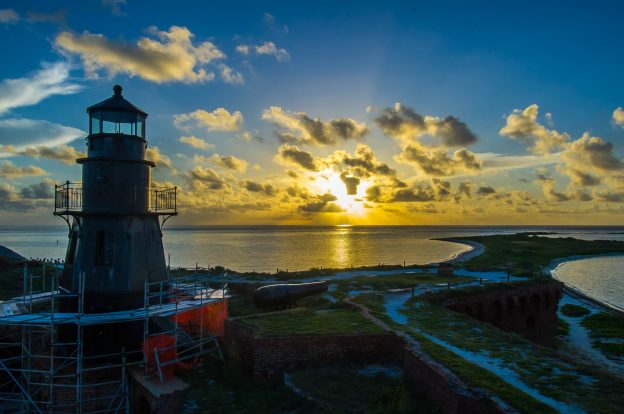















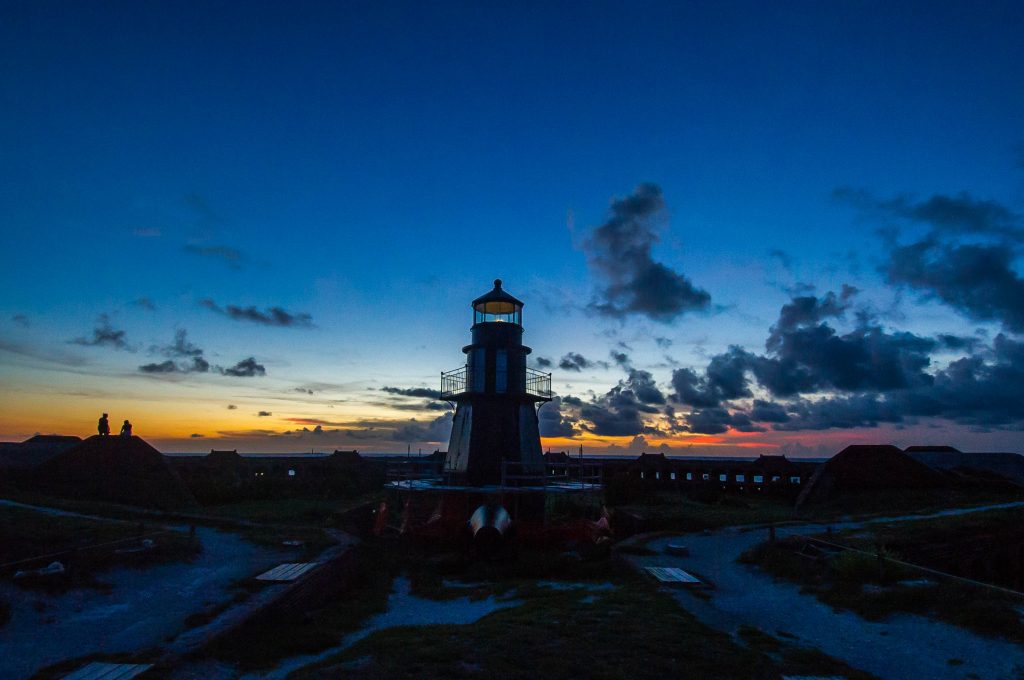
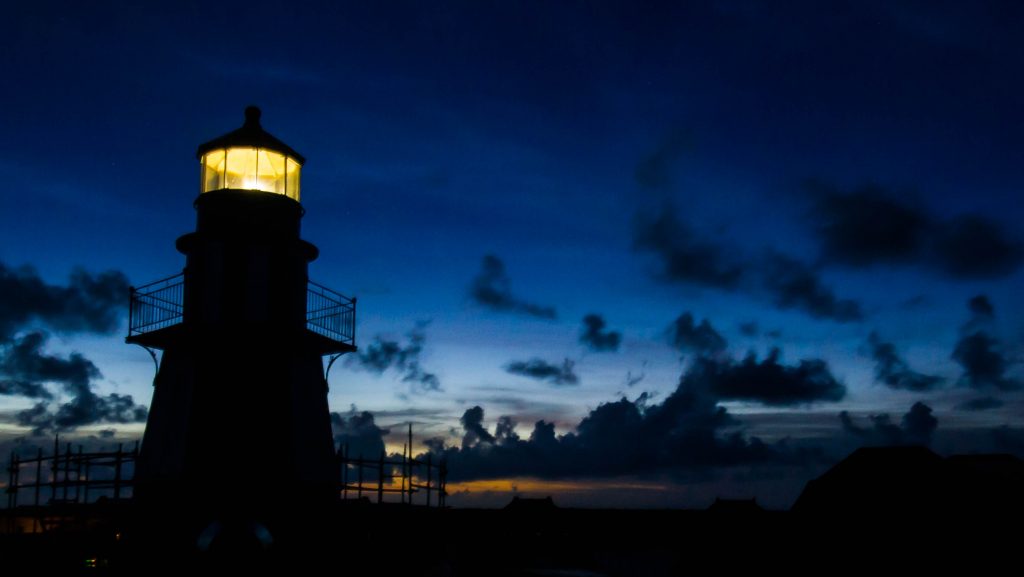







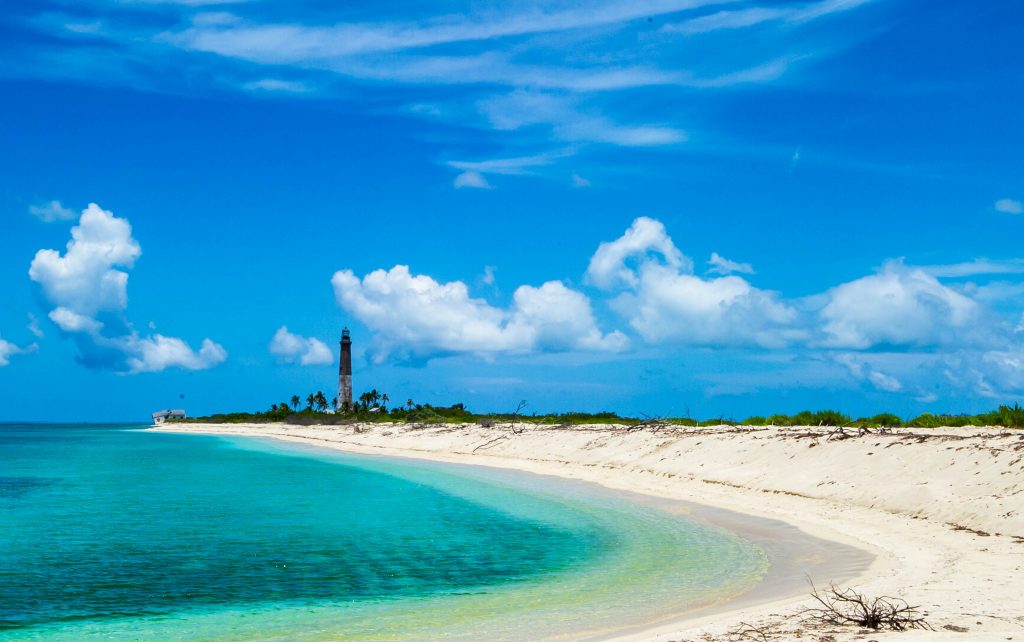


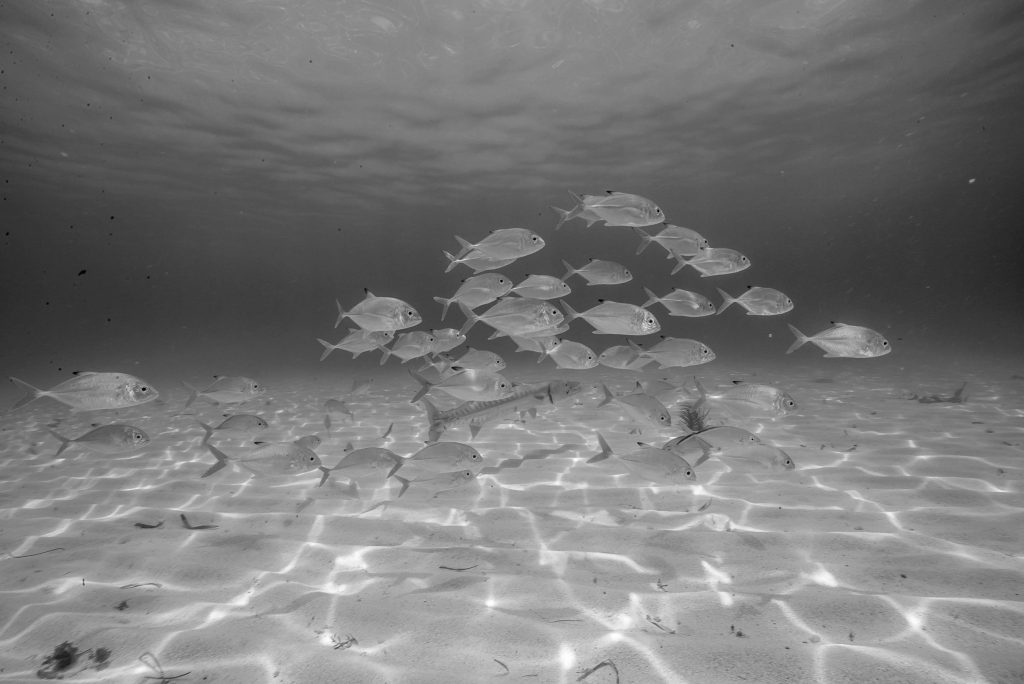
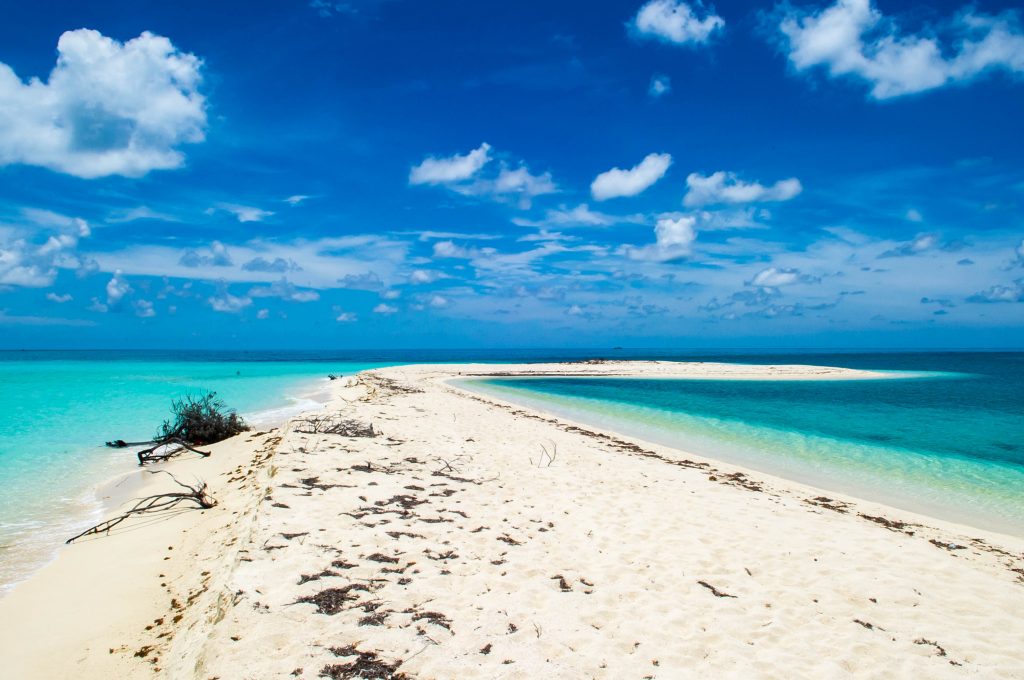
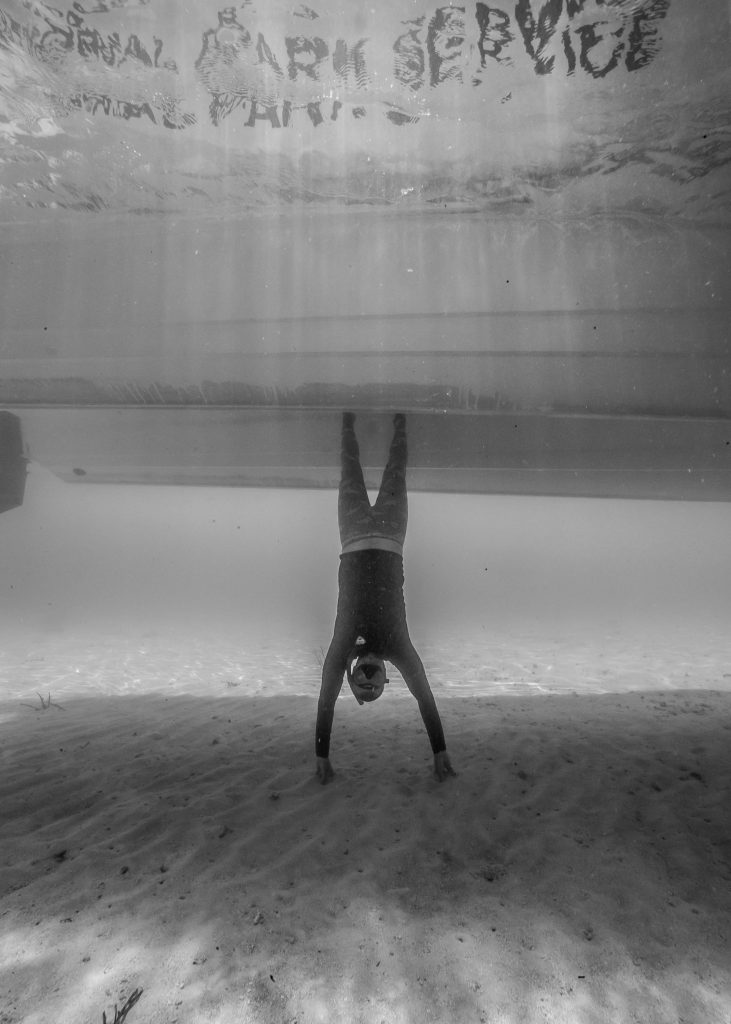
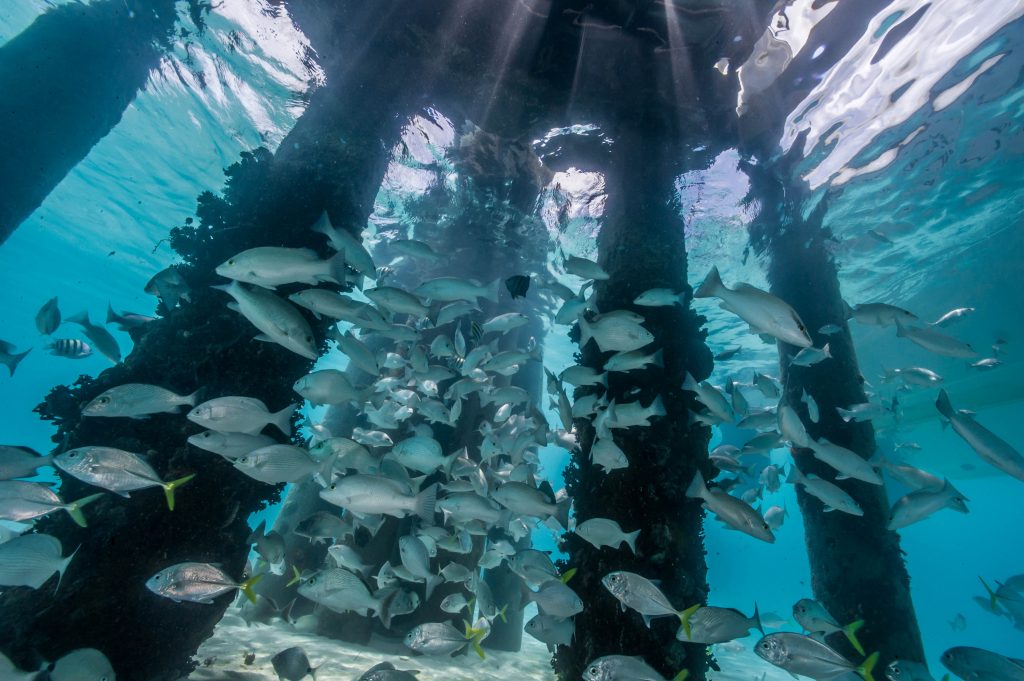

This was an incredible blog. Thanks for it. Are those little Medusa Fish in the moon jelly?